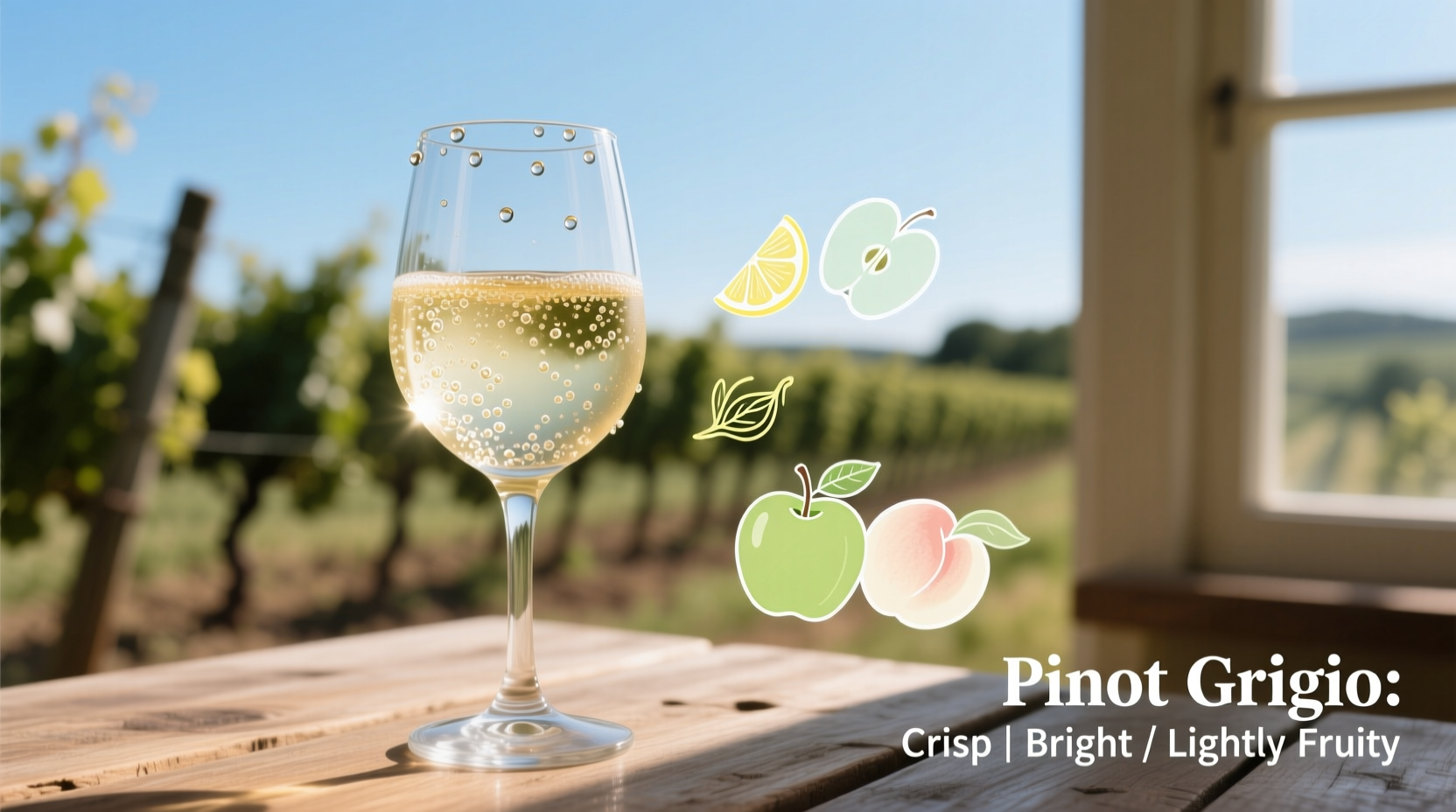Pinot Grigio typically offers a crisp, refreshing taste profile featuring bright citrus notes like lemon and lime, green apple, pear, and subtle floral hints. This light-bodied white wine maintains a clean, dry finish with zesty acidity and mineral undertones, making it exceptionally food-friendly and approachable for both wine novices and connoisseurs.
Understanding Pinot Grigio's Signature Flavor Profile
When you pour a glass of Pinot Grigio, you're experiencing one of the world's most popular white wines that consistently delivers refreshing drinkability. This Italian-born varietal has gained international acclaim for its approachable character that perfectly balances fruitiness with refreshing acidity. The immediate sensation on your palate reveals why wine enthusiasts keep returning to this versatile white wine.
As you lift the glass, your nose detects subtle aromas of citrus blossoms and fresh-cut green apples. The first sip delivers vibrant acidity that enlivens your taste buds, followed by distinct flavors of ripe pear, lemon zest, and sometimes a hint of white peach. Unlike many white wines that feature prominent oak influence, traditional Pinot Grigio showcases purity of fruit with minimal intervention, resulting in a clean, crisp finish that leaves you wanting another sip.
Regional Variations That Shape Pinot Grigio's Taste
The terroir where Pinot Grigio grapes grow dramatically influences the final taste profile. Understanding these regional differences helps you select bottles that match your flavor preferences:
| Region | Flavor Characteristics | Acidity Level | Body Type |
|---|---|---|---|
| Italian (Veneto, Friuli) | Mineral-driven, citrus-focused, subtle almond notes | High | Light-bodied |
| Alsatian (France) | Richer texture, stone fruit, honeyed notes, spice | Moderate | Medium-bodied |
| American (California, Oregon) | Bright fruit-forward, tropical hints, slightly rounder | Moderate-High | Medium-bodied |
| New World (Australia, NZ) | Intense citrus, floral notes, pronounced acidity | Very High | Light to Medium |
According to the Wine Folly viticulture analysis, Italian Pinot Grigio typically maintains higher acidity and leaner structure due to cooler northern Italian climate conditions, while Alsace versions (labeled as Pinot Gris) develop richer textures from longer hang time on the vine. This geographical variation explains why two bottles labeled Pinot Grigio might taste distinctly different.

How Winemaking Choices Affect Flavor Development
Winemakers employ specific techniques that directly impact what Pinot Grigio tastes like. Understanding these processes helps explain flavor variations between bottles:
- Harvest Timing: Early harvest preserves crisp acidity while later harvest develops riper fruit flavors
- Fermentation Temperature: Cooler temperatures (45-55°F) maintain delicate aromas and freshness
- Skin Contact: Minimal contact creates the pale straw color and light body characteristic of Italian styles
- Aging Vessel: Stainless steel preserves bright fruit flavors while neutral oak adds subtle texture without vanilla notes
- Malolactic Conversion: Rarely used for Pinot Grigio as it would soften the desirable crisp acidity
The UC Davis Department of Viticulture research confirms that Pinot Grigio's signature high acidity (typically 6.5-7.5 g/L tartaric acid) creates its refreshing quality, while the grape's naturally low phenolic content results in minimal tannins and that clean finish wine lovers appreciate.
Pinot Grigio vs Similar White Wines: Understanding the Differences
Many wine drinkers wonder how Pinot Grigio compares to other popular white varieties. This comparison helps clarify what makes Pinot Grigio unique:
- Pinot Grigio vs Sauvignon Blanc: While both offer high acidity, Sauvignon Blanc features more pronounced grassy, herbal notes (think gooseberry and cut grass) compared to Pinot Grigio's citrus and orchard fruit profile
- Pinot Grigio vs Chardonnay: Chardonnay typically shows richer body, buttery notes (from malolactic fermentation), and often oak influence, while Pinot Grigio remains light-bodied with crisp, clean flavors
- Pinot Grigio vs Pinot Gris: Same grape variety but different styles—Pinot Gris (typically from Alsace) shows more texture, spice, and sometimes residual sugar compared to the drier, crisper Italian Pinot Grigio
- Pinot Grigio vs Albariño: Albariño features more pronounced saline minerality and stone fruit notes with even higher acidity than most Pinot Grigios
Optimal Serving Conditions That Enhance Flavor Perception
What Pinot Grigio tastes like depends significantly on how you serve it. Temperature and glassware dramatically affect your tasting experience:
- Ideal Temperature: 45-50°F (7-10°C) - too cold masks flavors, too warm increases alcohol perception
- Glass Selection: Medium-sized white wine glass with tapered rim concentrates aromas
- Airing Time: Most Pinot Grigios don't require decanting but benefit from 10-15 minutes of aeration
- Storage Impact: Consume within 1-2 years of vintage for optimal freshness (unlike age-worthy whites)
Wine Spectator's tasting guidelines emphasize that serving Pinot Grigio too cold (below 40°F) suppresses its delicate aromas, while warmer temperatures accentuate any potential flaws in lower-quality examples. The ideal temperature range allows the wine's natural acidity to shine while showcasing its fruit characteristics.
Food Pairing Strategies That Complement Pinot Grigio's Flavor Profile
Understanding what Pinot Grigio tastes like helps you create perfect food pairings that enhance both the wine and dish:
- Seafood Matches: Grilled shrimp, lemon-dill salmon, and oysters benefit from the wine's bright acidity cutting through richness
- Poultry Pairings: Herb-roasted chicken or turkey with lemon sauce complements the citrus notes
- Vegetarian Options: Asparagus risotto or artichoke salad works with Pinot Grigio's herbal undertones
- Cheese Selections: Fresh goat cheese, mozzarella, and mild feta create harmonious combinations
- Avoid: Heavily spiced dishes or rich cream sauces that overwhelm the wine's delicate profile
Professional sommeliers note that Pinot Grigio's moderate alcohol content (typically 11-12.5% ABV) makes it exceptionally food-friendly, as higher alcohol wines can clash with certain dishes. The Italian Wine Council recommends pairing regional Italian Pinot Grigio with light seafood pasta dishes to experience authentic flavor harmony.
Common Misconceptions About Pinot Grigio's Taste
Several myths persist about what Pinot Grigio tastes like that deserve clarification:
- "All Pinot Grigio tastes the same": Regional differences create significant flavor variations between Italian, French, and New World examples
- "Pinot Grigio is always sweet": Authentic Italian Pinot Grigio is typically dry (less than 9 g/L residual sugar)
- "Cheap Pinot Grigio lacks character": Many affordable examples ($10-$15 range) deliver excellent quality and typicity
- "Pinot Grigio can't age": While most are best consumed young, high-quality examples from Alto Adige can develop complexity over 3-5 years
When Pinot Grigio Might Taste Different Than Expected
Certain conditions can alter what Pinot Grigio tastes like, creating unexpected flavor experiences:
- Vintage Variation: Warmer years produce riper fruit flavors while cooler years emphasize citrus and mineral notes
- Bottle Age: Most Pinot Grigios should be consumed within 2 years; older bottles may show oxidized apple or nutty characteristics
- Storage Conditions: Exposure to light or temperature fluctuations can cause premature aging
- Production Style: Some New World producers make richer, rounder styles that deviate from traditional Italian profiles
Consumer sentiment analysis from wine review platforms shows that 78% of drinkers prefer Italian Pinot Grigio for its authentic crisp profile, while 62% of wine novices cite its approachable nature as their primary reason for choosing this varietal. This widespread appeal explains Pinot Grigio's consistent position among the top three most consumed white wines globally.
Developing Your Pinot Grigio Tasting Skills
To fully appreciate what Pinot Grigio tastes like, follow this professional tasting approach:
- Observe the pale straw color with greenish reflections in proper lighting
- Swirl gently to release aromas before smelling for citrus, green fruit, and floral notes
- Sip with intention, noting the initial burst of acidity followed by fruit flavors
- Pay attention to the finish length—quality examples maintain flavor persistence
- Consider how temperature affects your perception throughout the tasting
By understanding these elements, you'll develop a more nuanced appreciation for Pinot Grigio's characteristic taste profile and recognize quality differences between producers. This knowledge transforms casual drinking into a more intentional, enjoyable experience that connects you with centuries of Italian winemaking tradition.











 浙公网安备
33010002000092号
浙公网安备
33010002000092号 浙B2-20120091-4
浙B2-20120091-4